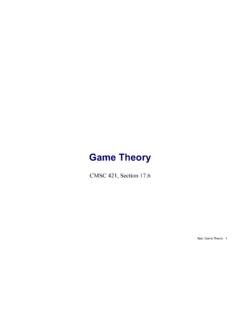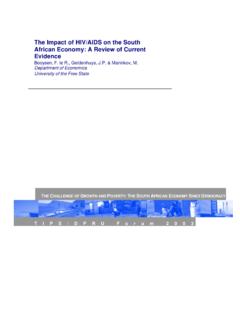Transcription of The Strength of Weak Ties Author(s): Mark S. Granovetter ...
1 The Strength of Weak Ties Author(s): Mark S. Granovetter Source: American Journal of Sociology, Vol. 78, No. 6 (May, 1973), pp. 1360-1380. Published by: The University of Chicago Press Stable URL: Accessed: 15-06-2015 01:58 UTC. Your use of the JSTOR archive indicates your acceptance of the Terms & Conditions of Use, available at info/about/ JSTOR is a not-for-profit service that helps scholars, researchers, and students discover, use, and build upon a wide range of content in a trusted digital archive. We use information technology and tools to increase productivity and facilitate new forms of scholarship. For more information about JSTOR, please contact The University of Chicago Press is collaborating with JSTOR to digitize, preserve and extend access to American Journal of Sociology.
2 This content downloaded from on Mon, 15 Jun 2015 01:58:15 UTC. All use subject to JSTOR Terms and Conditions The Strength of Weak Ties'. Mark S. Granovetter Johns Hopkins University Analysis of social networks is suggested as a tool for linking micro and macro levels of sociological theory. The procedure is illustrated by elaboration of the macro implications of one aspect of small-scale interaction: the Strength of dyadic ties. It is argued that the degree of overlap of two individuals' friendship networks varies directly with the Strength of their tie to one another. The impact of this principle on diffusion of influence and information, mobility oppor- tunity, and community organizationis explored.
3 Stress is laid on the cohesive power of weak ties. Most network models deal, implicitly, with strong ties, thus confining their applicability to small, well- defined groups. Emphasis on weak ties lends itself to discussion of relations between groups and to analysis of segments of social struc- ture not easily defined in terms of primary groups. A fundamental weakness of current sociological theory is that it does not relate micro-level interactions to macro-level patterns in any convincing way. Large-scale statistical, as well as qualitative, studies offer a good deal of insight into such macro phenomena as social mobility, community organization,and political the micro level, a large and increas- ing body of data and theory offers useful and illuminatingideas about what transpires within the confines of the small group.
4 But how interaction in small groups aggregatesto form large-scalepatterns eludes us in most cases. I will argue, in this paper, that the analysis of processes in interpersonal networks provides the most fruitful micro-macro bridge. In one way or another, it is through these networks that small-scale interaction becomes translated into large-scale patterns, and that these, in turn, feed back into small groups. Sociometry, the precursorof network analysis, has always been curiously peripheral-invisible, really-in sociological theory. This is partly because it has usually been studied and applied only as a branch of social psy- chology; it is also because of the inherent complexities of precise network analysis.
5 We have had neither the theory nor the measurement and sam- pling techniques to move sociometry from the usual small-group level to that of larger structures. While a number of stimulating and suggestive 1 This paper originated in discussions with Harrison White, to whom I am indebted for many suggestions and ideas. Earlier drafts were read by Ivan Chase, James Davis, William Michelson, Nancy Lee, Peter Rossi, Charles Tilly, and an anonymous referee;. their criticisms resulted in significant improvements. 1360 AJS Volume 78 Number 6. This content downloaded from on Mon, 15 Jun 2015 01:58:15 UTC. All use subject to JSTOR Terms and Conditions The Strength of Weak Ties studies have recently moved in this direction (Bott 1957; Mayer 1961.)
6 Milgram 1967; Boissevain 1968; Mitchell 1969), they do not treat struc- tural issues in much theoretical detail. Studies which do so usually involve a level of technical complexity appropriate to such forbidding sources as the Bulletin of Mathematical Biophysics, where the original motivation for the study of networks was that of developing a theory of neural, rather than social, interaction (see the useful review of this literature by Coleman [1960]; also Rapoport [1963]). The strategy of the present paper is to choose a rather limited aspect of small-scale interaction-the Strength of interpersonal ties-and to show, in some detail, how the use of network analysis can relate this aspect to such varied macro phenomena as diffusion, social mobility, political orga- nization, and social cohesion in general.
7 While the analysis is essentially qualitative, a mathematically inclined reader will recognize the potential for models; mathematical arguments, leads, and references are suggested mostly in footnotes. THE Strength OF TIES. Most intuitive notions of the " Strength " of an interpersonal tie should be satisfied by the following definition: the Strength of a tie is a (probably linear) combination of the amount of time, the emotional intensity, the intimacy (mutual confiding), and the reciprocalservices which characterize the Each of these is somewhat independent of the other, though the set is obviously highly of operational measures of and weights attaching to each of the four elements is postponed to future It is sufficient for the present purpose if most of us can agree, on a rough intuitive basis, whether a given tie is strong, weak, or 2 Ties discussed in this paper are assumed to be positive and symmetric.
8 A compre- hensive theory might require discussion of negative and/or asymmetric ties, but this would add unnecessary complexity to the present, exploratory comments. 3 Some anthropologists suggest "multiplexity," that is, multiple contents in a relation- ship, as indicating a strong tie (Kapferer 1969, p. 213). While this may be accurate in some circumstances, ties with only one content or with diffuse content may be strong as well (Simmel 1950, pp. 317-29). The present definition would show most multiplex ties to be strong but also allow for other possibilities. 4 Included in "absent" are both the lack of any relationship and ties without sub- stantial significance, such as a "nodding" relationship between people living on the same street, or the "tie" to the vendor from whom one customarily buys a morning newspaper.
9 That two people "know" each other by name need not move their relation out of this category if their interaction is negligible. In some contexts, however (disasters, for example), such "negligible" ties might usefully be distinguished from the absence of one. This is an ambiguity caused by substitution, for convenience of exposition, of discrete values for an underlying continuous variable. 1361. This content downloaded from on Mon, 15 Jun 2015 01:58:15 UTC. All use subject to JSTOR Terms and Conditions American Journal of Sociology Consider,now, any two arbitrarilyselected individuals-call them A and B-and the set, S = CyD, E.
10 , of all persons with ties to either or both of The hypothesis which enables us to relate dyadic ties to larger structures is: the stronger the tie between A and B, the larger the propor- tion of individuals in S to whom they will both be tied, that is, connected by a weak or strong tie. This overlap in their friendship circles is predicted to be least when their tie is absent, most when it is strong, and intermediate when it is weak. The proposedrelationshipresults, first, from the tendency (by definition). of stronger ties to involve larger time commitments. If A-B and A-C ties exist, then the amount of time C spends with B depends (in part) on the amount A spends with B and C, respectively.


















